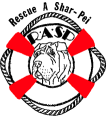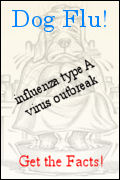|
|
Past Newsletters

The CSPCA Charitable Trust needs your support through donations to continue vital research projects. Your donation is tax deductible.

RASP (Rescue A Shar-Pei) is a volunteer group with a concern for abandoned and abused Shar-Pei in Illinois / Indiana / Wisconsin and surrounding areas.
|


|

|
|

Volume 2, Issue 1
July 1998
Ear Problems and the Chinese Shar-Pei
Shar-Pei have one of the most unique
ear conformations in the dog world.
The tight ear flap and a predisposition to narrow ear canals ("stenotic
ear canals") can spell disaster in trying to maintain a healthy ear. The
normal ear anatomy is similar to an
ice cream cone. The cone represents
the vertical ear canal and this connects to a short horizontal ear canal
which leads to the ear drum. Most
problems involve the vertical ear canal.
I consider it normal for the Shar-Pei
to have what I call "yeast over
growth". This is seen as a dark
brown accumulation in the upper
part of the ear. This does not appear
to bother the dog — the ear is not
red indicating inflammation, there is
not a foul odor and the ear is not
painful. Routine care involves using Q-tips and alcohol to clean this material out of the ear. This usu-
ally must be done weekly. Often this discharge becomes more severe and clinical signs develop such
as head shaking, foul odor to the ears and pain when
cleaning the ears. Medical intervention is necessary
at this time — a veterinary examination is needed. A sample of
the discharge is examined under the microscope and often a bacterial culture with sensitivity is often indicated. I often do not
clean the ears in the clinic during the exam — sedation is usually
necessary to do a thorough job. Medication is dispensed based
on what the underlying cause may be.
My opinion: ONCE A SHAR-PEI HAS AN
EAR PROBLEM IT WILL ALWAYS
HAVE EAR PROBLEMS. YOU WILL
NOT CURE THE PROBLEM, YOU WILL
ONLY CONTROL IT THROUGH
ROUTINE EAR MAINTENANCE.
The primary problem with ear cleaning in the
Shar-Pei breed centers around inadequate
training and tack of control of the dog. If the
dog will not let you clean the ears you will not
be able to treat the ears- The training process
begins in puppyhood and involves discipline
and positive reinforcement methods which are
beyond the scope of this article. Suffice it to
say that you should train your dog as a puppy
to tolerate ear cleaning. I will also be the first
to say that some of the problem in cleaning the
ears rests in the most common method of ear
cleaning used today - the cotton swab.
Improper use of the cotton swab results in
trauma to the ear canal with swelling, pain and
an uncooperative patient.
The best way to clean the ear canal is to "float"
debris out of the canal using an ear cleaning
solution. A wide variety of such solutions are
available on the market with none being better
than any of the others.
Try different ones and see which works best for
you. My personal favorites are Pan-Otic and Nolvasan Otic. Do not use hydrogen peroxide! The
foaming action bothers the dog and the peroxide
breaks down into oxygen and water in the ear. It is
usually wise to clean the ears outdoors because the
principle here is to allow the cleaning solution to
loosen the debris and the dog to shake the material
out of the ear.
The ear canal is filled up with the cleaning solution,
gently massaged, and then the dog is allowed to
shake its head. Stand Back! Material tends to
catch on the inside of the ear flap where it is wiped
off with cotton bails and the whole process is repeated. This is done several times until no more
debris is collected. At this point a cotton swab can be
gently inserted into the ear canal to soak up any remaining ear cleaning solution. Do not clean the ear
with the cotton swab! After the ear is thoroughly
dried, the appropriate ear medication is instilled into
the ear canal as directed by your veterinarian. It is
often a good training technique to give the dog some
sort of a special treat at this point to positively reward the dog. This may make future sessions more
pleasant. In ears that have severe disease, it is often a good idea to treat the ear for several days with
medication first before attempting to clean the ears.
This allows the swelling and pain to subside first
and allow the dog to tolerate the cleaning procedure
better. In such cases it may also be
a good idea to have your veterinarian anesthetize the
dog and clean the ears before any home therapy is
done. This also allows your veterinarian the opportunity to examine the ear more thoroughly.
There is a special category of ear disease that is
often seen in Shar-Pei called "hyperplastic otitis" or
"proliferative otitis". This disease is characterized
by multiple warty or polyp-like growths in the ear
canal and ear flap. These growths further impede
air circulation in the ear and contribute to the ear
disease. Why some dogs develop these growths and
others don't is not known. It probably represents an
extreme response to chronic infection. Oral steroid
therapy is often used in an attempt to minimize the
formation of these warty growths. Many times surgery is necessary in these cases. One type of
surgery involves removing the warty growths using
electrocautery.
Orthopedic Problems and the Chinese Shar-Pei
 Shar-Pei have several types
of orthopedic problems
which are hereditary in nature.
Shar-Pei have several types
of orthopedic problems
which are hereditary in nature.
ELBOW DYSPLASIA - is actually a complex of developmental problems seen in
young Shar-Pei. These include ununited medial coronoid process, ununited
anconeal process and ostochondritis dissecans of the
humeral condyles. The
ununited medial coronoid
process appears to be the
more common problem in
the Shar-Pei. This is caused
by a small fragment
chipped off the radius bone
in the elbow; The radius is
the main weight-bearing
bone in the forearm and
the main symptom seen is a
chronic front leg lameness
which gets worse with exercise. As time passes, arthritis develops in the
elbow and the elbow becomes
swollen. Treatment involves surgery to remove
the fragment. Often, both
elbows are involved.
HIP DYSPLASIA - a malformation of the hip
joint is still seen
in the breed.
Shar-Pei breeders
have made great
strides in reducing the incidence
of this disease.
When I first got into the
breed in the 1980's the incidence of hip dysplasia
was around 19% and in the
1990's the rate has
dropped to about 7%. This
decrease is largely due to
breeders using results of
OFA hip evaluations to
guide their breeding programs. The Orthopedic
Foundation for Animals
(OFA) uses board-certified
veterinary radiologists to
grade hips and help breeders select individuals free
of the condition to use in
their breeding programs.
Symptoms of hip dysplasia
range from no outward
signs at all to severe debilitating arthritis in the hips.
The diagnosis is based on
radiographs taken with the
dog under anesthesia.
Treatment ranges from
pain medication and glycosamine/chondroitin sulfate
combinations to total hip
replacement.
PATELLAR LUXATION - is
commonly know n as "loose
knee caps". The kneecap or
patella is held in place by a
groove located at the end
of the femur or upper leg
bone in the rear leg. When
the groove is not deep
enough the patella can slip
off to the side of the stifle
or knee joint. Most commonly This is seen as an intermittent lameness which
ends when the kneecap
"pops" back into normal
position. Treatment is surgery to deepen the groove
and tighten the surrounding ligaments.
ANTERIOR CRUCIATE
LIGAMENT RUPTURE -
seems to be a common
knee injury in the Shar-Pei.
The anterior cruciate ligament prevents movement
of the lower rear leg forward independently of the
upper leg. Usually this injury occurs due to
hyperextension of the knee during
exercise. Symptoms are
fairly severe rear leg lameness associated with a
traumatic incident. Surgery Is
necessary to stabilize the
knee joint. Many times the
other knee will be injured
in the same manner several
months after the first knee
is repaired.
|
|

